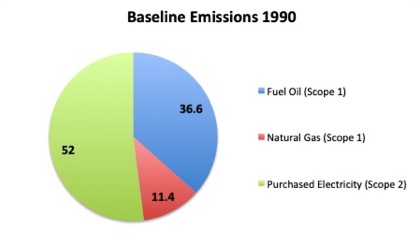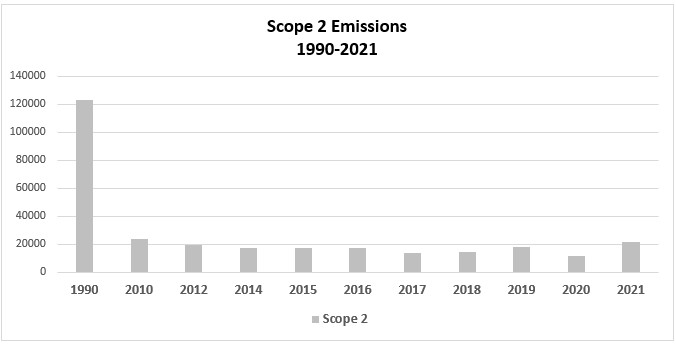Greenhouse Gas Inventory
Stony Brook University maintains on an annual basis a comprehensive report on utility cost and consumption. Much of the data used in the Greenhouse Gas Emissions Inventory was gathered from this source. We also relied on information provided by the staff at the cogeneration facility that services the university. Our Department of Transportation and Parking Operations provided us with the fuel information from the University fleet.
| Reporting Year | Scope 1 (MTCO2e) |
Scope 2 (MTCO2e) |
Total Emissions | % Reduction from Baseline |
|---|---|---|---|---|
| Reporting Year1990 (Baseline Year) | Scope 1 (MTCO2e)114,027 |
Scope 2 (MTCO2e)123,311 |
Total Emissions237,338 | % Reduction from Baseline-- |
| Reporting Year2010 | Scope 1 (MTCO2e)148,254 |
Scope 2 (MTCO2e)23,501 |
Total Emissions171,755 | % Reduction from Baseline28% |
| Reporting Year2012 | Scope 1 (MTCO2e)148,526 |
Scope 2 (MTCO2e)19,409 |
Total Emissions167,935 | % Reduction from Baseline29% |
| Reporting Year2014 | Scope 1 (MTCO2e)160,695 |
Scope 2 (MTCO2e)17,220 |
Total Emissions177,915 | % Reduction from Baseline25% |
| Reporting Year2015 | Scope 1 (MTCO2e)151,404 |
Scope 2 (MTCO2e)17,393 |
Total Emissions168,797 | % Reduction from Baseline29% |
| Reporting Year2016 | Scope 1 (MTCO2e)152,078 |
Scope 2 (MTCO2e)17,494 |
Total Emissions169,573 | % Reduction from Baseline29% |
| Reporting Year2017 | Scope 1 (MTCO2e)153,846 |
Scope 2 (MTCO2e)14,089 |
Total Emissions167,935 | % Reduction from Baseline29% |
| Reporting Year2018 | Scope 1 (MTCO2e)159,579 |
Scope 2 (MTCO2e)14,585 |
Total Emissions174,164 | % Reduction from Baseline27% |
| Reporting Year2019 | Scope 1 (MTCO2e)149,742 |
Scope 2 (MTCO2e)18,103 |
Total Emissions167,845 | % Reduction from Baseline29% |
| Reporting Year2020 | Scope 1 (MTCO2e)129,309 |
Scope 2 (MTCO2e)11,528 |
Total Emissions140,884 | % Reduction from Baseline41% |
| Reporting Year2021 | Scope 1 (MTCO2e)129,080 |
Scope 2 (MTCO2e)21,678 |
Total Emissions150,846 | % Reduction from Baseline36% |
| Reporting Year2022 | Scope 1 (MTCO2e)132,168 |
Scope 2 (MTCO2e)19,129 |
Total Emissions151,297 | % Reduction from Baseline36% |
| Reporting Year2023 | Scope 1 (MTCO2e)136,962 |
Scope 2 (MTCO2e)17,161 |
Total Emissions153,854 | % Reduction from Baseline35% |
Changes to Operational Boundaries
As part of SBU's commitment to tracking GHG emissions from the past decade, a change was made to the university's baseline data. In addition to the completed inventories that cover 2014 up to the current year, SBU has changed its baseline year to 1990 in order to track progress towards state energy requirements. As a state entity, SBU is required to reduce GHG emissions to meet EO22 goals.
The decision to use 1990 as SBU's baseline year will provide a clear picture of how effective university conservation measures have been on total university emissions. In order to remain consistent regarding future inventories, SBU will continue to include these boundaries in our emission reduction strategies.
Baseline Results
The total emissions found in the new baseline year of 1990 were 237,388 MTCO2e. This figure was fairly equally distributed between Scope 1 and Scope 2, with 52% of emissions being indirect (Scope 2). The majority of these indirect emissions were from consuming purchased energy. Emissions sources from 1990 are displayed in Figure 1 below.

GHG Emissions 2010-2019
Starting in 2019, SBU has committed to preparing an annual GHG Emissions Inventory for the university using the SIMAP tool, created by The Sustainability Institute at the University of New Hampshire. In addition to completing the university’s 2019 report, SBU has also submitted emissions inventories for the past five years. These reports together with the existing inventories filed in 2010 and 2012 provide a clear look at the progress made in relation to the 1990 baseline.
With the completion of the 2019 inventory, SBU is reporting a 36.81% reduction in net emissions against the baseline year. These figures place SBU in good standing in their goal to accomplish a 40% reduction in net emissions by 2030, as per the New York State Energy Plan requirements. Net emission figures are represented below.

Scope 1
When comparing current day emissions to those from 1990, SBU has shown a slight increase of 16.53% in Scope 1 emissions. Much of this increase is the direct result of the 45 megawatt cogeneration facility operating on SBU campus since 1995. Since 2010, increased efficiency in the cogeneration plant has led to a 10.53% decrease in Scope 1 emissions at SBU. Net Scope 1 emissions are shown below.

Scope 2
The introduction of the cogeneration plant in 1995 also had a dramatic effect on the university’s Scope 2 emissions. As shown in figure 4 below, SBU’s Scope 2 emissions have decreased over 85% since 1990. Additionally, SBU has seen its Scope 2 emissions decrease over 27% since 2010, meaning the reduction perhaps goes deeper than just a change in source.

For More Information on SBU Emissions
Visit Second Nature's webpage for more information on the university's completed GHG Emissions Inventories and how conservation measures are changing our campus.
Get More InfoStony Brook Reaches EO88 Goal
SBU met its requirement of a 20% reduction in Energy Use Intensity to fulfill Executive Order 88, a year in advance of the targeted completion date.
Read More
